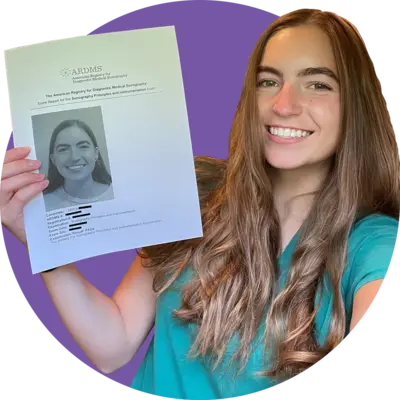
Focused content
Interactive live seminars
Expert teachers
There’s an enormous amount of content to digest to pass an exam.
It doesn’t matter where you are in your career, the medical field of sonography requires understanding a huge amount of content in order to pass registry exams. This is enough to overwhelm the best sonographer.
No sonographer should have to navigate an endless amount of information alone.
ESP can help if…
you’re burdened with the pressure of taking the exam.
you’re losing sleep because your job is on the line.
you’re unsure you can retain all the information needed to pass.
ESP is different than most online registry review courses. We don’t rely on just one way to prepare for certifications. Instead, we use a combination of our people, our methods, and our resources to make sure you’ll be ready to face your exam with confidence.
People
Our faculty is here for you. While other registry instructors teach you everything they know, ESP instructors teach you everything YOU need to know.
Resources
Registration includes a workbook with plenty of space to take notes. It also includes X-Zone-our practice test to help set you up for success!
Method
We break down the exam outline into an easily understood format focusing on the relevant content. This makes it easier to retain the knowledge for the exam.

We understand the pressure you are facing.
Our instructors faced these challenging exams too. That is why we created a simpler way to prepare for the test. With 30+ years of creating successful learners, we can help you prepare to pass your exam and achieve your certification!
1
Register
Choose your course and register. We offer multiple classes every month.
2
Attend
Attend and practice. Your registration comes with resources you need to successfully prepare for your exam.
3
Test
Tackle your exam with confidence. We don’t want to brag, but you may actually enjoy taking the exam.
We’ve helped thousands of sonographers just like you pass registry exams. A career in sonography is rewarding as you can make a real difference in patients’ lives through diagnostics.
Understanding Ultrasound Physics Textbook
- An essential resource for sonographers
- Complex content in easy to teach & learn formats
- X-ZONE: 120 practice questions included
- Written by Sidney K. Edelman, Ph.D.
Live exam prep webinars
- Interactive, live webinars
- Comprehensive registry review workbook included
- X-ZONE: online practice questions included
- Taught by experienced subject matter experts
- Focused content
Study Tools
- Quiz cards in Q & A format to identify content requiring additional study
- Video cases to review Adult Echo Anatomy & Pathology tested on the exam
- Created by experienced subject matter experts
- Quizzes to confirm your specialized knowledge and practice test-taking
On-demand cmes
- Relevant content to enhance technical skills
- Easy to follow video & question format
- Credits accepted by ARDMS, CCI, ARRT, & Sonography Canada
9 out of 10 sonographers who attended an ESP webinar said they would recommend us to you!
To be a sonographer and advance your career, you will need to tackle a registry exam. We have created a simpler way for you to do that. Our professors love helping you break down the content and focus on what you need for the exam. Here are a few questions we commonly answer.
What do I get with a webinar registration?
With your registration, you will receive the following:
-
- Course workbook (will be mailed to you)
- Access to the live, interactive registry review webinar
- 6 weeks access to X-ZONE, our online practice exam questions
- 12 Continuing Education Credits issued by the SDMS.
Disclaimer: Each registrant ensures they understand that most certification organizations do not apply credit for repeated SDMS CME Activities during the same certification period.
When will I receive my workbook?
Our primary goal is to ensure you have the workbook before the start of the webinar. About 2-3 weeks out from the date of the webinar, we start the workbook shipment process. Workbooks are shipped in order of registration. If you register early, your workbook will be shipped in the first batch shipment. If you wait to register until the last day (the cut-off date), you will receive your workbook a few days before the webinar begins. We recommend you register as soon as you are able to avoid any shipment complications. Tracking information for your workbook will be e-mailed to you. That e-mail may get filtered to your spam or junk folder so please check those regularly.
What is X-Zone?
To solidify what you learn in the webinar and your course workbook, you need to challenge yourself with practice questions. X-ZONE is our online platform that contains the practice questions for each course. You will have 9 months from the date of your registration to activate X-ZONE. Once activated, your 6 week subscription will begin.
When should I take my exam after the webinar?
After I pass the exam, then what?
Then you finally get to sleep, see the sun, hang out with your friends again, and spend time with your family!
All kidding aside, we want to share in your good news! E-mail a headshot of you holding your pass results to info@esp-inc.com. Please include a brief testimonial on how ESP helped you pass. We will send you a free ESP T-shirt.
Can I cancel my registration and get a refund?
We get it, life happens. If you need to reschedule, follow these guidelines:
To transfer to another course within the same calendar year at no cost, simply email info@esp-inc.com.
To cancel your registration, email info@esp-inc.com. If the following conditions are met, you will be eligible for a refund less a $50 administrative fee:
-
- You have not activated your online subscription to X-ZONE.
- We have not shipped your workbook.
You will not be eligible for a refund if any of the following conditions are true:
-
- You have activated your X-ZONE subscription.
- Your workbook has been shipped.
- You attended the seminar.
May I audio or video record the webinar?
Audio and video recording is strictly prohibited. All participants who register agree to abide by our Terms of Use.
You shall not copy, reproduce, republish, upload, post, transmit or distribute the Service or the Materials in any way. You shall not sell, resell, license, sublicense, rent, lease, transfer, assign, distribute, grant a security interest in, or otherwise transfer any rights to, or commercially exploit, the Service or any Materials contained in or made available to you in the course of using the Service or use the Service to run or as part of a service bureau, outsourced, or managed services arrangement.
Do I need the textbook for the webinar?
As helpful as the Understanding Ultrasound Physics textbook is, it is not necessary for taking our prep courses.

Three skills to help eliminate test-taking stress
Download these helpful study strategies to help you prepare for your certification exam.
[gravityform id=”7″ title=”false” description=”false” ajax=”true” tabindex=”49″ field_values=”check=First Choice,Second Choice”]